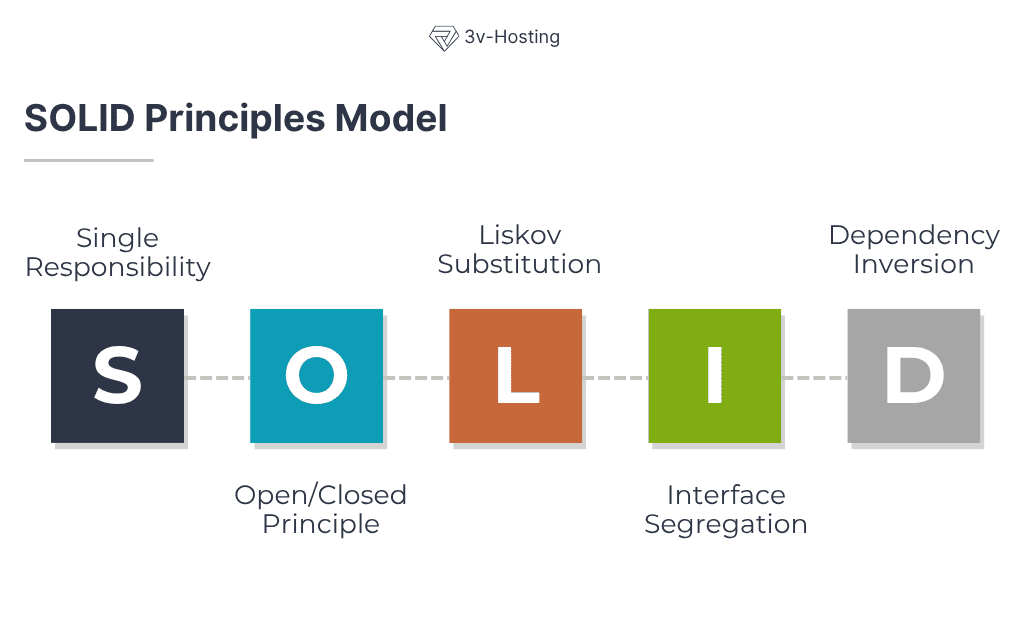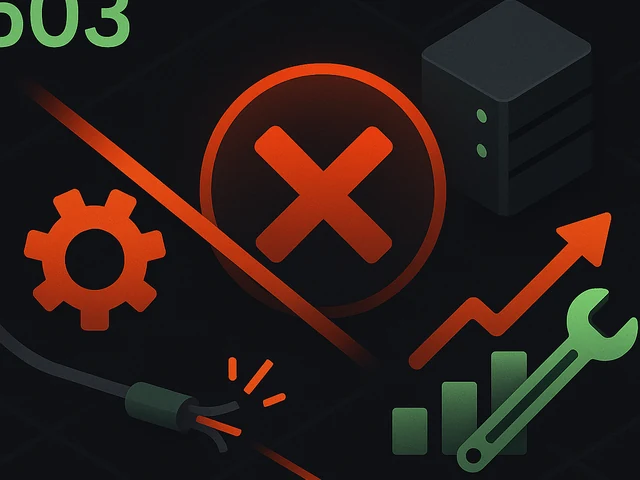
In the realm of Linux system administration, monitoring and managing processes is a critical aspect of maintaining system stability and efficiency. The ps comma...
3v-Hosting Blog
11 min read
Modern software systems and complexes are constantly evolving, as they are continuously developed, supplemented, integrated with external services, containerized, launched in Kubernetes clusters, gradually increasing their functionality and complexity. And the larger the project, the more often the team encounters situations where a small change in one module leads to unexpected failures in other parts of the system. This effect is called architectural fragility.
The SOLID principles help to avoid this. These are a set of fundamental recommendations for object-oriented design that are applicable in any modern stack: Python, Java, PHP, C#, TypeScript, Go (via interfaces), as well as in most popular frameworks such as Django, NestJS, Laravel, Spring Boot, .NET Core, etc.
In this article, we will take a detailed look at the SOLID principles, understand their logic, and consider examples of their implementation in real-world cases.
SOLID is an acronym proposed by Robert C. Martin (Uncle Bob). It combines five key principles of sustainable architecture:
SOLID helps solve tasks that are critical for IT systems, such as:
Systems created without using SOLID also work in principle, but they are much less resilient to changes. Systems created using SOLID last for years.

In real-world development, changes happen all the time, and they are often the cause of architectural problems. The more actively a product develops, the more often changes are made to the code base: new payment scenarios are added, business logic changes, additional integrations with external APIs appear, microservices or containerization via Docker and Kubernetes are implemented.
In the early stages, this may seem insignificant when a few simple conditions are added, a couple of new methods are introduced, or minor changes are made to the service's logic. But over time, each change begins to affect neighboring modules, causing a so-called “ripple effect” when a change in one part of the system unexpectedly breaks a completely different part, often not directly related to it.
The reason for this is simple: the architecture was not originally designed for growth. It lacks clear boundaries of responsibility, abstractions, stable contracts between components, and loose coupling.
The SOLID principles help avoid this problem. They create an architecture that can withstand change, does not descend into chaos, and remains predictable for the development team. As a result, the code base evolves rather than undergoing painful and costly rewrites.
Now let's take a closer look at each component of the SOLID principle.
The Single Responsibility Principle is the foundation of the entire architecture. It states:
A class should have only one reason to change.
When a module is responsible for several tasks at once, it becomes a point of maximum fragility. Any changes in one aspect easily break others.
This is a typical problem in projects such as:
SRP makes code:
Bad example violating SRP
class UserManager:
def register(self, user):
self.save_to_db(user)
self.send_email(user)
def save_to_db(self, user):
...
def send_email(self, user):
...
Good example with SRP compliance
class UserRepository:
def save(self, user): ...
class EmailService:
def send_welcome(self, user): ...
class AuthManager:
def __init__(self, repo, email):
self.repo = repo
self.email = email
def register(self, user):
self.repo.save(user)
self.email.send_welcome(user)
This principle defines the ability of an architecture to expand without changing existing code.
An ideal system is designed so that when you add new logic, you first create new classes, and second, the old classes remain unchanged. Compliance with these two simple rules greatly increases stability and reduces the risk of regression.
Most often, OCP is violated when developers start adding more and more new conditions. For example:
Anti-pattern (if-else hell)
def calculate_tax(region, amount):
if region == “eu”:
return amount * 0.2
elif region == “us”:
return amount * 0.1
elif region == “asia”:
return amount * 0.15
# and so on
OCP-friendly option
class TaxStrategy:
def calculate(self, amount):
raise NotImplementedError()
class EuropeTax(TaxStrategy):
def calculate(self, amount):
return amount * 0.2
class USTax(TaxStrategy):
def calculate(self, amount):
return amount * 0.1
Now adding a new region is simply a new class.
LSP guarantees correct inheritance. It states:
A subclass must completely replace the base class without breaking its behavior.
This principle protects the project from hierarchies that look logical but do not work logically.
Bad example
class Bird:
def fly(self): ...
class Penguin(Bird):
def fly(self):
raise Exception(“Penguins can't fly!”)
Correct option
class Bird: ...
class FlyingBird(Bird):
def fly(self): ...
class Penguin(Bird): ...
LSP is especially important in domain models, where an incorrect hierarchy can completely destroy the logic of the system.
ISP combats bloated interfaces, and if an interface includes methods that the client does not use, this is a violation.
This often leads to consequences such as unnecessary dependencies, stub methods, as well as non-compliance with SRP and complicated tests.
Example of a bad interface
interface Machine {
print(): void;
scan(): void;
fax(): void;
}
interface Printable { print(): void; }
interface Scannable { scan(): void; }
interface Faxable { fax(): void; }
The main idea is very simple: small interfaces are always better than large ones.
The DIP principle states:
High-level modules should not depend on low-level implementations, only on abstractions.
This is the foundation of loosely coupled systems.
Bad example
class ReportService:
def __init__(self):
self.logger = FileLogger()
Good example
class Logger: ...
class FileLogger(Logger): ...
class CloudLogger(Logger): ...
class ReportService:
def __init__(self, logger: Logger):
self.logger = logger
Virtually all modern frameworks use DIP automatically through DI containers.
In practice, SOLID principles almost never exist in isolation. Although each of them solves its own specific problem, their true power is revealed when they are applied together. Architecture ceases to be a set of disparate classes and becomes a system of interconnected but loosely coupled components that naturally support the growth of the project.
Each principle solves its own category of problems: SRP is responsible for module responsibility, OCP for extensibility, LSP for inheritance correctness, ISP for interface purity, and DIP for dependency stability. However, it is their joint implementation that creates an architecture that not only works, but works predictably and safely under the load of changes.
For example, by implementing SRP, you automatically prepare the code for DIP, because individual components are easier to link through abstractions. By applying OCP, you make the system more flexible - but without ISP, interfaces soon become too cumbersome. And if you follow LSP, your inheritance hierarchies remain honest and logical, which makes extending behavior through OCP safe.
Thus, SOLID is not a set of separate rules, but a complementary architectural framework that makes code resistant to change, protects against structure degradation, and reduces project development costs. When the principles work together, the architecture becomes natural, easy to read, and technically elegant.
SOLID interaction table
| Principles | Result |
|---|---|
| SRP + DIP | modularity, testability |
| OCP + ISP | easy extension without side effects |
| LSP + OCP | correct inheritance behavior |
| SRP + ISP | clean interfaces and services |
| DIP + OCP | plugin-like architecture |
Violating SOLID principles almost never leads to immediate disasters. In the early stages, the project may work quite stably, and the apparent absence of problems creates a false sense of reliability. However, as the product grows, the number of modules increases, new developers appear, and the business logic becomes more complex, the architecture gradually begins to “delaminate” and degrade.
Gradually, this begins to manifest itself in small ways, such as: changing a small function unexpectedly breaks the working functionality in another part of the system; tests that previously passed consistently begin to depend on the environment; simple edits require a cascade of modifications in neighboring classes. The further the degradation of the architecture goes, the higher the cost of each change becomes, both in terms of implementation time and risk.
Therefore, it is important to learn to recognize the early signs of SOLID non-compliance. These signs serve as indicators that the project is moving towards increased fragility, unpredictability, and growing technical debt. Identifying them in time can greatly simplify further refactoring and maintain system manageability.
Below are the main symptoms that indicate that the architecture has begun to deviate from SOLID principles and requires attention.
| Symptom | Violated Principle |
|---|---|
| Class is too large | SRP |
| Too many if/else statements | OCP |
| Subclass changes parent behavior | LSP |
| Interface contains dozens of methods | ISP |
| Component cannot be tested | DIP |
Although the SOLID principles were originally developed for object-oriented programming, their ideas have long gone beyond classes and methods. Today, SOLID is effectively applied in many other areas, from REST API design to infrastructure as code, from microservice architecture to deployment automation in Kubernetes.
The essence of SOLID lies in the manageability, modularity, and predictability of architecture. And this is exactly what modern development requires: multi-component systems operating in isolated environments, with many external dependencies and constant changes in infrastructure.
In DevOps practices, the principles of SRP and DIP are easily seen in well-organized Terraform modules or Ansible roles. In microservices, ISP and OCP become the cornerstones of loosely coupled services that interact via stable API contracts. In backend projects on Django, NestJS, Laravel, or .NET Core, adherence to SOLID makes the code the basis for confident scaling and fault tolerance.
Therefore, SOLID is not just about classes. It's about thinking, or, if you will, about architecture in a broad sense. It's about how to create modules that can be extended, combined, safely changed, and tested. Below are the most important areas of DevOps and backend practices where SOLID principles are particularly evident and bring real benefits.
Implementing SOLID in an existing project does not require a complete rewrite of the code. It is a gradual process that can be integrated into the normal development cycle. The main idea is to consistently improve the architecture, strengthening those points in the system where changes are particularly difficult. It is precisely this gradual, evolutionary approach that allows you to improve code quality without stopping development and without the risk of disrupting product stability.
Below is a brief, practical strategy that experienced architects most often follow when transitioning to SOLID in existing systems.
Analyze the areas of code that break most often or cause the most difficulty when changes are made. These are usually large services, controllers, or classes that combine many responsibilities. Working with these areas gives quick results.
Repeated fragments are a common sign of SRP violation. Combining such sections into separate, independent components makes the code more stable and facilitates its further expansion.
If a class depends on a specific implementation (e.g., storage type, payment method, or logging method), this is a signal to introduce abstraction. Interfaces help separate the variable part and prepare the system for extensibility.
This is a natural way to implement OCP. New logic should appear in the form of additional classes or strategies, rather than through the extension of conditional constructs within existing modules.
When fixing one section, improve the neighboring one if it does not require significant effort: simplify methods, separate classes, remove unnecessary dependencies. Small improvements have a big effect in the long run.
Automated tests allow you to make changes more boldly, fix unwanted side effects, and help you gradually build SRP, DIP, and OCP.
Dependency injection containers simplify working with abstractions, allow you to substitute implementations in tests, and reduce coupling between modules.
This short set of questions helps you quickly assess how well your current code complies with SOLID principles. If at least some of them raise doubts, the project may need architectural attention.
1. Does a function or method perform more than one action?
If so, this is a sign of SRP violation: responsibility is blurred, testability deteriorates, and code becomes fragile.
2. Do you have to edit an existing class to add new logic?
This behavior indicates an OCP violation - the system is not sufficiently extensible and prone to regressions.
3. Does the subclass behave differently than expected from its base class?
This is a clear violation of LSP: an incorrect hierarchy can lead to unpredictable errors.
4. Does the interface force the implementation of methods that the component does not use?
In this case, ISP is violated: the interface is overloaded and requires separation.
5. Does the class depend on a specific implementation instead of an abstraction?
Such code violates DIP and complicates testing, extension, and replacement of dependencies.
If at least two points cause problems, the architecture is already moving towards increased fragility, and it is worth considering the gradual implementation of SOLID principles and refactoring of problem areas.
Yes. Even a small project quickly becomes complex, and basic compliance with SOLID reduces technical debt and makes the code ready for growth.
Only if you apply it excessively. SOLID simplifies the structure and reduces coupling, but excessive abstraction can lead to overengineering.
Yes. The SRP, OCP, and DIP principles work well at the module, function, and overall architecture levels, making the code less fragile.
If you can't add a small feature without creating several new classes or interfaces, then you're using too many abstractions.
Yes. The ideas of SRP, DIP, and OCP fit perfectly with pure functions, composition, and weak module coupling.
It helps. SOLID naturally coincides with the principles of microservice design: isolation, loose coupling, and clear boundaries between components.
The SOLID principles are not a strict set of rules, but a mature professional approach to design. They help to form architectures that can be safely developed, tested, and scaled even in conditions of constant change. Applying SOLID makes code predictable, reduces coupling, and allows new features to be implemented without destroying existing logic.
Projects built with SOLID in mind are better able to withstand increased load, infrastructure changes, expansion of the development team, and the transition to microservice or cloud architectures. Such systems integrate better with DevOps practices, CI/CD processes, and the modern culture of continuous delivery.
SOLID is the foundation that allows a software product to live long, evolve without chaos, and not accumulate critical technical debt. It is an investment in code sustainability, quality, and the ability to support business tasks for many years to come.

HTTP 503 (Service Unavailable) means that your server is overloaded or undergoing maintenance. Find out what causes this error, how to fix it, and how to preven...

Manage your VPS and websites easily with the Ispmanager control panel. Create domains, databases, and backups in one click, monitor performance, and secure your...

LiteSpeed has quietly become a serious contender among web servers, combining Apache’s flexibility with Nginx’s raw speed. Thanks to its event-driven architectu...